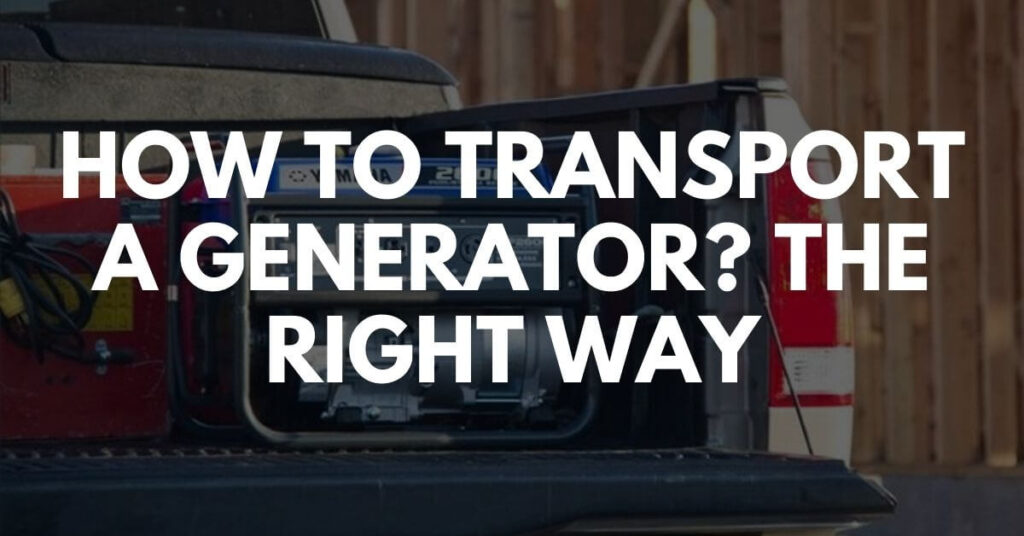When camping or in remote locations, having a steady power supply is crucial to ensure the comfort and convenience of your experience. Generators have become a popular solution for providing power in these situations. However, transporting a generator to your desired location can be a challenge if you don’t know the right way to do it.

That’s why I’ve created this article specifically for you, so that you can learn how to transport your generator safely and efficiently. By following the tips and guidelines provided in this article, you’ll be able to transport your generator with ease and peace of mind, allowing you to enjoy the benefits of having electricity in remote locations.
So, without further delay, let’s dive in and learn how to transport generators the right way.
How to Transport A Generator: The Best Way
To safeguard your investment and ensure your generator arrives at its destination in good working condition, it’s vital to take the necessary precautions during transportation. By following the steps I will describe below, you can ensure that your generator is properly secured and protected during transport, preserving its value and functionality.
1. Cool Down The Generator Before Transportation
It’s important to keep in mind that moving a hot generator can cause severe damage to its components and could also result in burns to the person handling it. Therefore, before transporting your generator, make sure that it has cooled down completely. If the generator has been running, turn it off and give it at least 15 minutes to cool down. This will not only protect the generator but also ensure your safety during the transportation process.
2. Shut Off the Fuel Valve
When transporting your generator, it’s critical to take the necessary precautions to protect it from damage. One of the key steps is to make sure that the fuel valve is turned off before moving the generator. This will prevent fuel from spilling into the crankcase due to the vibrations caused by the transport and can cause damage to the engine. To prevent such issues, it is advisable to always turn off the fuel valve whenever the generator is not in use and especially when it’s being transported. This simple step can save you from costly repairs and ensure that your generator is in good working condition when you arrive at your destination.
3. Place the Generator In a Desired Place
Transporting a generator on its side is never a good idea, as it can easily cause damage to the generator, leading to fuel and oil leaks. Therefore, when transporting your generator, make sure it is always upright.
To ensure that your generator is transported safely and securely, make sure your vehicle is suitable for the task. A truck or trailer is the best option for transporting generators, as they have the capacity to accommodate them. If you don’t have access to a truck or trailer, you can invest in an A-frame or hitch-mounted cargo carrier to safely transport your generator.
It is important to note that placing your generator on top of your vehicle, even if you have a luggage rack, is not safe. Most automobiles cannot safely transport portable generators, which can weigh up to 250 pounds, and this can be dangerous in case of an accident. Furthermore, placing a generator inside a car is not recommended, as the fumes from the fuel tank can be hazardous to you and your passengers.
4. Safe and Secure Transport
Properly storing and transporting your generator is essential for maintaining its longevity and ensuring safe operation. Once you’ve selected the ideal location for your generator, take the necessary steps to secure it. A weather-resistant container can provide an ideal storage solution, or you can modify a heavy-duty plastic container or “tuff box” to serve as a carrying case. When packing the generator, ensure it is secure and won’t slip or slide during transport. If you choose not to use a container, protect the generator from the elements by wrapping it in a heavy-duty tarp and securing it with bungee cords. To ensure the safety of your generator during transport, avoid placing anything on top of it and unload it in a way that is easy for you when you reach your destination.”
5. Unload the Generator
Remove all protective coverings such as tarps and untie any straps securing the generator. Enlist the help of another person to relocate the generator to a stable and even surface. Once in place, thoroughly inspect the equipment for any signs of damage incurred during transportation.
6. Transporting Fuel
Fueling your generator at the campground is an essential step in the transportation process. To ensure a successful trip, it is crucial to properly secure the fuel can cap and ventilation, as an unsecured or open cap can lead to spills. To avoid leakage and spills, it is best to store the fuel can in the trunk or truck bed rather than the passenger compartment. To prevent movement during transportation, keep the fuel container upright by using a bungee cord or a truck box. It is important to avoid leaving the fuel container in the vehicle for long periods of time, as this can lead to leakage of fumes and even combustion. Whenever possible, remove the fuel container immediately after use for added safety and peace of mind during transport.
FAQs
Is it possible to transport a generator on its side?
It is imperative that a generator is never turned upside down or placed on its side as doing so can lead to severe damage to the engine parts from oil or fuel leaks, not to mention other internal engine parts. When transporting a generator, it is essential to keep it in an upright position at all times to prevent any damage from occurring.
What is the best way to move a heavy generator?
To safely remove the generator from the truck, a crane or forklift can be employed to lift it onto a designated concrete pad. Precision is key in this process, so use the machinery’s controls to carefully place the generator on the concrete surface. Once the generator is securely in place, secure it to the concrete pad using concrete anchors for added stability.
Conclusion
By reading this article, you should now have a clearer understanding of how to safely transport a generator. By adhering to the steps outlined above, you can guarantee a successful and hassle-free trip, whether it be for camping or any other purpose.
It is also important to remember that placing generator fuel containers inside your vehicle is not only dangerous but also should be avoided at all costs.
Lastly, it is crucial to understand that your generator represents a significant financial investment, thus it’s important to be well-informed and take the necessary precautions to ensure its safe transport and preservation.




